 |
|
 |
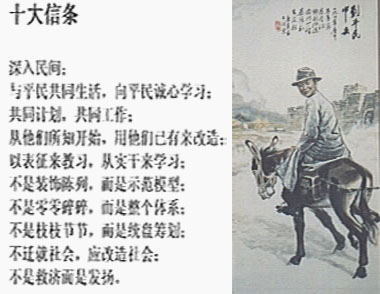 |
78 years ago, Yan devoted to training a new generation of well-informed, productive and healthy farmers in Dingxian County. His Rural Reconstruction Movement was an integrated program involving education, livelihood, public health and self-governance that targeted the interlocking problems of illiteracy, poverty, disease and civic inertia among peasants in developing countries. He later revised this program based on his experiences in South America, Africa and Southeast Asia. In 1987 U.S. President Ronald Reagan granted him the Presidential End Hunger Award for lifetime achievement.
In 1926 Dr. Yan started his education program for peasants in Dingxian and established an education promotion society. Three years later he and his |
family moved to Dingxian, where his former residence still stands. Within the same year, more than 60 other intellectuals also settled in Dingxian. Dr. Yan commented that the move from Beijing to Dingxian was not merely a geographical difference of a few hundred kilometers but a backward leapfrog over a dozen-century span. It was probably the first time in Chinese history that intellectuals had actually put into practice the slogan of “returning to the countryside.” Dr. Yan and his comrades overcame many difficulties in trying to adapt to rural life as they attempted to analyze China’s social conditions in the country. This they did through comprehensive investigations of one county and, based on this model, worked out a plan for rural reconstruction. Dr. Yan described his project as “a Western laboratory transposed to rural Dingxian.” More than 500 intellectuals worked in this Dingxian “lab.”
Dr. Yan taught the villagers to read and write, helped them improve their strains of cotton and breeds of pig and established a village clinic and teachers’ school for girls. He tried to improve general conditions in Dingxian through his broad education program. Dr Yan also set up a radio station that started its daily broadcast each day at 6.00 am with a weather forecast. Among China’s then 80 or so radio stations, Yan’s was the only one aimed at rural dwellers.
|
The Dingxian experiment ended in 1937 with the War of Resistance Against Japanese Aggression.
Improving the native pig through hybridization with an American breed was a small, though significant, piece of MEM's work in Dingxian. MEM's leader was Yan Yangchu, known to many westerners as James Yan. MEM began what was to be known as the "Dingxian Experiment" in 1926.
The choice of Dingxian (Ding County), in the northern province of Hebei, came about via an invitation from a local political leader who was already engaged in reform efforts of his own.Although the movement's activities were strictly secular, Yan's connections to the YMCA and other missionary groups secured key funding. Other vital funding sources came from American organizations (the Rockefeller Foundation singled
|
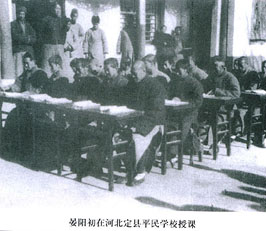 |
| MEM out for donations because of its Chinese leadership and local support) and from the Nationalist government, led by Chiang Kaishek. The Dingxian Experiment was cut short in 1937 when reformers were forced to flee--with their prized Poland China boars in tow--from invading Japanese troops to a new base in Hunan Province. Three years later he and his family moved to Dingxian, where his former residence still stands. Within the same year, more than 60 other intellectuals also settled in Dingxian. Dr. Yan commented that the move from Beijing to Dingxian was not merely a geographical difference of a few hundred kilometers but a backward leapfrog over a dozen-century span.
|
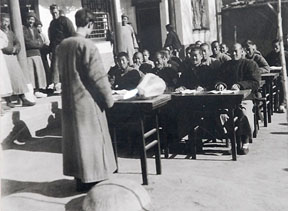
Yan in Dingxian |
It was probably the first time in Chinese history that intellectuals had actually put into practice the slogan of “returning to the countryside.” Dr. Yan and his comrades overcame many difficulties in trying to adapt to rural life as they attempted to analyze China’s social conditions in the country. This they did through comprehensive investigations of one county and, based on this model, worked out a plan for rural reconstruction. Dr. Yan described his project as “a Western laboratory transposed to rural Dingxian.” More than 500 intellectuals worked in this Dingxian “lab.”
|
At that time, most rural areas in China was quite conservative. Yan’s Rural Reconstruction Movement was an integrated program involving education, livelihood, public health and self-governance that targeted the interlocking problems of illiteracy, poverty, disease and civic inertia among peasants in developing countries. He focused great attention on training teachers, because he believed that rural teachers took the burden of both children’s education and rural reconstruction.
By education, people are expected to improve their knowledge, productivity, health and organization power through education. The three teaching methods referred to school, social and family education.
|
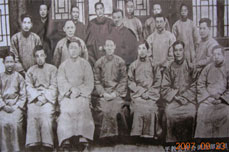
MEM researchers |
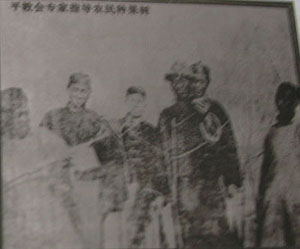
Rural production guidance |
Yan reduced the Chinese vocabulary of forty thousand characters to the 1,300 most common characters and published four readers, which cost twelve cents total. With this handbook, Yan started the four month-span education with the purpose of getting rid of illiteracy. Yan’s success also depended on local celebrities. In 1903, Mr. Mi supported Yan to build new school. In 1908, Mi had set a good example for others.
Since the foundation of China, great changes happened in rural areas, especially the rural land and administrative mode. Dingxian Trial attracted attention from all walks of society. On Dec 17, 1932, Mr. Edgar Snow reported that Dingxian trail was the most dramatic rural reconstruction in China. In 1938, Mr. Mao, the chairman of China, visited Yan and expressed his thanks to Yan’s contribution. |
| Dr. Yan Yangchu (James Yen), when he led them in his Rural Reconstruction Movement. Dr. Yan was the only Asian ever to rank with such luminaries as Albert Einstein and John Dewey. In 1943 he won the Copernican Citation as one of the “ten greatest revolutionaries of our time.” |
|
|
 |
|